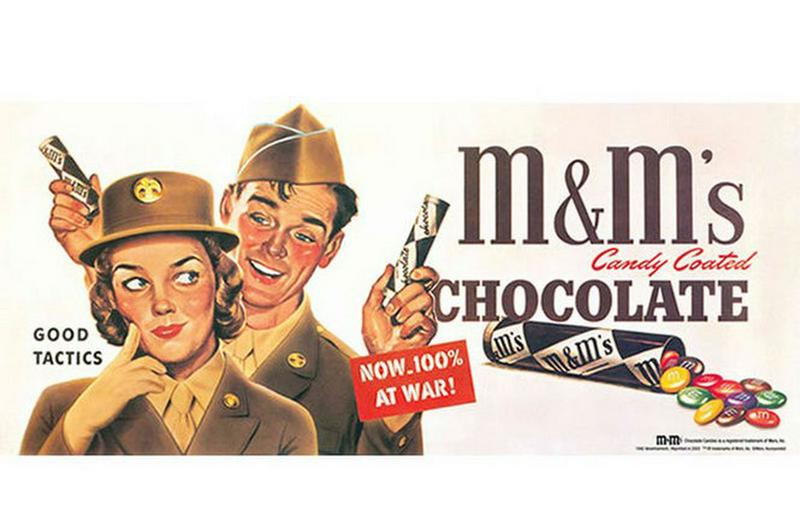M&M’s Began as a Treat for the U.S. Military
By | October 12, 2022

One of America’s best-loved candies, M&M’s, was first introduced in 1941 but not to the general public. In fact, average citizens couldn’t get their hands on the chocolatey morsels until 1947. For the first six years of the candy’s history, it was only available to members of the U.S. military service overseas in World War II. Let’s take a look at the early beginnings of M&M’s.
Forrest Mars
Forrest Mars’ was the son of Frank Mars, the founder of the Mars, Inc., a candy company, but he didn’t see his father much as he was growing up. His parents had divorced, and he was estranged from his father. As an adult, he reconnected with his father and worked for him at Mars, Inc. It was not a happy reunion. Forrest Mars butted heads with his father and grew frustrated that the elder Mars dismissed his ideas for new products or expansion opportunities.
In 1933, Forrest Mars broke ties with his father and moved to England. He took jobs with Nestle and Tobler, and later purchased a company that produced canned meat for dog food. He spent time in Spain in the mid to late 1960s during the Spanish Civil War. It was there that he made an important observation.

Chocolate Morsels
Forrest Mars noticed that soldiers serving in the Spanish Civil War enjoyed eating a chocolatey treat called Smarties – not to be confused with the non-chocolatey candy Smarties we have today. These Smarties were a British-made candy that was basically a morsel of chocolate with a hardened sugar syrup coating surrounding it. The hard sugar coating prevented the chocolate morsels from becoming a big, melty mess.
When Forrest Mars returned to the U.S., he started his own food production company, Food Products Manufacturing, and launched the Uncle Ben’s line of rice dishes and Pedigree dog food. But he didn’t forget about the little chocolate morsels called Smarties. He began to experiment with making a similar candy-coated chocolate treat.
M&M’s
On March 3, 1941, Forrest Mars received a patent for the process developed for making candy-coated chocolate. He changed things up a bit by coloring the sugar syrup shell in bright colors. He began to manufacture his new candy treat, which he called M&M’s after his own last name and the last name of his business partner, Mars and Murrie. He packaged the candies in little cardboard tube, like the ones used for M&M minis today.

Bad and Good Timing
Forrest Mars picked a bad time to start making his chocolate M&M’s. The United States was entering World War II meaning that supplies of nearly everything, including chocolate, was severely limited. But Mars had an in. His business partner, Bruce Murrie was the son of William F. R. Murrie who, at the time, was the president of Hershey Chocolate. Since Hershey controlled the rationing of chocolate during World War II, The senior Murrie struck a deal with his son to supply the chocolate needed to make M&M’s but only if William Murrie could claim 20% of the ownership of the M&M’s candy.
M&M’s and the U.S. Military
Drawing on his observations from the Spanish Civil War, Forrest Mars approached the United States military with samples of his M&M candies in hand. He pitched them on the idea that chocolate could be a tasty moral booster for American troops serving overseas. He demonstrated that the hard candy coating ensured that the chocolate wouldn’t melt into a gooey mess and the cardboard tube packaging made it easier to ship the candy to the front lines.
The military loved Mars’s M&M’s. They contracted with Forrest Mars to purchase large quantities of M&M’s to hand out to soldiers along with chocolate bars which were already part of each soldiers’ rations. Mars ramped up production of the candies in his New Jersey factory. The contract with the military was so large that Mars couldn’t make any additional M&M’s to sell to civilians.

A Ready-Made Fan Base
By the time World War II ended and Forrest Mars was ready to introduce his M&M’s candies to the American public in 1947, he found that he had a ready-made fan base. Soldiers returning from war sought out the candy-coated chocolate morsels that they loved so much while serving overseas. Once M&M’s hit the store shelves, the former soldiers snatched them up for themselves and for their families. Mars used the advertising slogan “Melts in your mouth, not in your hands” to highlight the benefits of the candy.
In 1954, Forrest Mars introduced peanut M&M’s, which were an immediate favorite, despite the fact that Mars himself had a lifelong peanut allergy. Later, M&M’s were made with caramel and pretzels, too. When Frank Mars died, his Mars, Inc. company passed to Forrest Mars who combined his company with his father’s to make one large candy empire.
The company maintains its close association with the military. To this day, the Mars company participates in the U.S. Military Meals Ready to Eat Program and ships M&M’s, as well as Skittles and Snickers, to deployed troops.